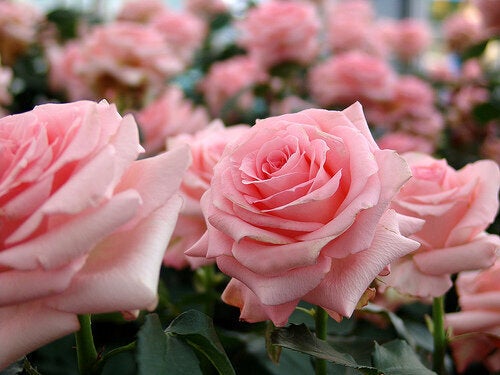
Placed delicately on the breakfast table is an adorable miniature hat box, filled to the brim with Sweet Avalanche and Coolwater roses. Nestled delicately amidst the fragrant petals, a tiny heart-shaped card reveals sweet sentiments of love from a Valentine's Day admirer.
Available to order online from Waitrose, this delicate arrangement costs £60.00 - with the promise of free delivery thrown in for good measure. With supply now constantly outstripping demand, the price of a Valentine's Day rose is often three or four times the standard cost. With growing conditions in the UK being inhospitable in February, the majority of the flowers available in supermarket bouquets will thus be imported by plane from sunnier climes - such as Kenya.
A world away from the fog, sleet and ice of the UK, north-west of Nairobi is Kenya's Lake Naivasha. Fringed in papyrus and yellow-barked acacias, this fresh-water lake with its unique eco system is not only home to flocks of flamingos and pods of sleepy hippopotamus, it is also the centre of Kenya's $360 million flower industry. It is here, 4,500 miles from the UK that one third of all cut flowers bought in Britain are grown. Originally a grazing land for the Masai, today colossal stretches of white plastic reflect back the equatorial light and house the thousands of blooms that are being cultivated for the European markets.
According to the Kenya Flower Council (KFC), the country's economy relies heavily on the agriculture sector, which contributes 22% of GDP. The floriculture industry is steadily growing in the volume and value of cut flowers and Kenya is now the lead exporter to the European Union with a market share of over 35%. With an ideal climate for producing a wide range of high quality blooms year round, the flower industry plays a major economic role with an estimated 500,000 (including over 90,000 flower farm employees) depending on flourishing business.
Despite the improvement in working conditions following the formation of the KFC Committee in 1996, concerns about health and safety arising from the use of chemical sprays and long working hours are still an issue. The minimum wage for flower farm employees currently stands at 3,765 KES per month (approximately £27) despite harsh economic times and regular exposure to harmful pesticides.
Fierce debates surrounding the miscellaneous amendment to the Labour Institution Act proposing an increase in wages to 10,000 KES per month have resulted in a number of worker strikes. In December 2012, over 3,000 workers from Karuturi flower farm abandoned their tools to protest non-payment of their salaries and poor working conditions. The strike was organised barely a month after the farm announced its intention to layoff over 1,500 employees (this figure was later reduced to 600).
The chairman of the Parliamentary Committee on Agriculture, John Mututho (who is sponsoring the wage increase) was reported in the Daily Nation newspaper saying, "The floriculture sector is one of the leading foreign exchange earners in the country but the workers have little to show for it." He goes on to stress that the enactment of the Bill is vital in improving conditions of living for a majority of the Kenyan workers.
The run-up period to Valentine's Day is key for the flower producers who make 40% of their annual revenue in February and March. Astoundingly, the production line is now so efficient that flowers picked in the early morning in Kenya, can be sold at Europe's flower auctions the same day.
The real question is, with a bouquet of two dozen roses costing around £60 in UK supermarkets and workers taking home under £1.00 a day, what kind of profits are the producers making?
Keen to promote its ecologically responsible business practices, Waitrose adheres info-stickers to its bouquets, alerting consumers to the origin of the blooms. Waitrose roses, many of which are sourced from Kenya are accompanied by information about the 'Waitrose Foundation', a partnership created in 2005 to: "Help improve the lives of the farm workers and small holders who grow our produce." According to the Foundation's website, instead of funding through a price premium, Waitrose - in conjunction with growers, importers and exporters - passes a percentage of profits into a trust to pay for educational, social and healthcare projects. An accompanying video features a Kenyan worker on the Ravine Flower Farm. She smiles and says: "I enjoy my work. The flowers depend on us and we depend on the flowers." The Ravine Flower farm may be fortunate in its support from both Fairtrade and the Waitrose Foundation, yet despite the claim that, "where possible, the workers use organic pest control to keep pesticides to a minimum" basic statistics reveal that only 12 out of the 59 hectares of the farm use organic sprays.
Kenya's general election is taking place in three weeks' time and the threat of a repeat of the violence that marred the country in 2007 is looming. Flower farm workers and their rights are not the priority right now, but for me, this Valentine's Day 2013, I think I will give the roses a miss. After all, they will all be dead by the end of the week and diamonds last much longer.
Sources: Daily Nation, Kenya's Labour Institution Act 2007, Lonely Planet Guide to Kenya [2012], War on Want, Kenya Flower Council, Wage Indicator, Waitrose Foundation, Fairtrade, Image courtesy of T. Kiya, Flickr Creative Commons